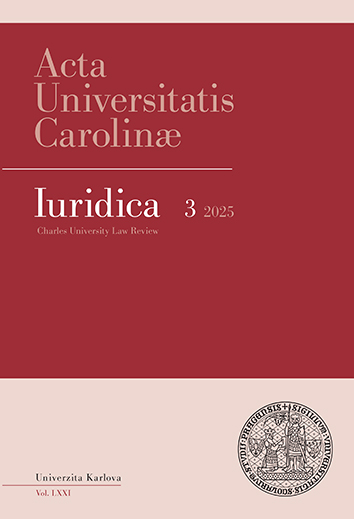Acta Universitatis Carolinae Iuridica (AUCI) is the main journal of the Faculty of Law of Charles University. It has been published since 1954 and is one of the traditional law journals with a theoretical focus.
As a general law journal, it publishes longer studies and shorter articles on any relevant issues in legal theory and international, European and national law. AUCI also publishes material relating to current legislative issues. AUCI is a peer-reviewed journal and accepts submissions from both Czech and international authors. Contributions by foreign authors are published in their original language – Slovak, English, German, French.
AUCI is a theoretical journal for questions of state and law. It is published by Charles University in Prague, Faculty of Law, through Karolinum Press. It is published four times a year, the dates of publication can be found here.
Articles published in AUCI undergo an independent peer review process, which is anonymous on both sides. Reviewers from the field give their opinion on the scientific quality of the paper and the suitability of publication in the journal. In the case of comments, the opinion is sent back to the author with the possibility of revising the text (see Guidelines for Authors – Per Review Process for more details).
The AUCI journal (ISSN 0323-0619) is registered in the Czech National Bibliography (kept by the National Library of the Czech Republic) and in the Index to Foreign Legal Periodicals (kept by the American Association of Law Libraries). AUCI has been assigned a periodical registration number MK E 18585.
In 2021 the journal AUCI was the first journal of the Faculty of Law of Charles University to be included in the prestigious international database Scopus. This Elsevier database is the largest abstract and citation database of peer-reviewed literature in the world. The editors of the journal expect from the inclusion in the elite Scopus database not only an increase in the readership of the journal, but also an increase in interest in the publication of papers by both Czech and foreign authors.
AUCI is an open journal and all its content is published both on the faculty website and on the Karolinum Press website. Access to it is free of charge. The homepage of AUCI is on the Karolinum Press website.
The AUCI journal uses the Creative Commons license: CC BY 4.0.
Long-term archiving of the digital content of the journal is provided by Portico.
AUC IURIDICA, Vol 44 No 3 (1998), 59–72
Mezinárodní ochrana práv dítěte
[The International Protection of the Rights of the Child]
Harald Christian Scheu
DOI: https://doi.org/10.14712/23366478.2025.266
published online: 31. 03. 2020
abstract
The adoption of the UN-Convention on the rights of the child was regarded a great success after a series of complicated negotiations. The Convention broke records in the field of international human rights protection. No other convention was signed and ratified by so many states and never before has a convention on the protection of human rights entered into farce so quickly. The draft Convention was adopted by the UN General Assembly on 20 November 1989, already on 26 January 1990 the Convention entered in to farce after the 60th State Party had submitted its ratification. After a detailed analysis it can’t be ignored that the Convention is at times a very weak compromise between conflicting interests. The Convention contains many promises and programmatic declarations, but offers very few answers to concrete questions. As for the implementation of the Convention into the legal order of the state party there remains a large scope for interpretation. The control mechanism provided by the Convention is a very weak one. The signatories are obliged to submit reports containing information about their efforts to implement the Convention. Then reports are examined by the UN Committee on the rights of the child. The Committee can address some recommendations to the governments of the states. It is evident that the ideas and aims of the authors of the Convention were not concrete enough to reach an effective solution. The same Jack of precision can be found in ·the European Convention on the Exercise of Children’s Rights (CECR) which was presented by the Council of Europe on 25 January 1995. The CECR intends to complement the UN convention. The CECR focuses on aspects of procedure in family matters before the Court and the administrative authorities. The mechanism of the CECR is rather weak, since the State Parties can specify, for which matters they will apply the commitments of the CECR. It can be said that the UN Convention on the rights of the child and the CECR are only the first step towards a general improvement of the children s legal position. The work of the UN Committee on the rights of the child is important for the development, but the success of the recommendations depends on the cooperation of the signatories. Same of them have shown little readiness to allow interventions into what they consider their sphere of sovereignty. Therefore the above mentioned legal documents do not bring a definitive solution to the problems linked with the situation of children in our world. It will be necessary to improve the international standard of children protection by more effective means. Children s rights are a very difficult question in the tension between the interests of child, the interests of the parents and the interests of the State. Solutions have to respect the special needs of children and they have to be more precise.

Mezinárodní ochrana práv dítěte is licensed under a Creative Commons Attribution 4.0 International License.
230 x 157 mm
periodicity: 4 x per year
print price: 65 czk
ISSN: 0323-0619
E-ISSN: 2336-6478
